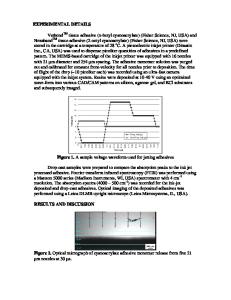Spray and Inkjet Printing of Hybrid Nanoparticle-Metal-Organic Inks for Ag and Cu Metallizations
- PDF / 3,367,246 Bytes
- 6 Pages / 612 x 792 pts (letter) Page_size
- 73 Downloads / 315 Views
Spray and Inkjet Printing of Hybrid Nanoparticle-Metal-Organic Inks for Ag and Cu Metallizations C. J. Curtis, D. L. Schulz†, A. Miedaner, J. Alleman, T. Rivkin, J. D. Perkins and D. S. Ginley National Renewable Energy Laboratory, 1617 Cole Blvd., Golden, CO 80401-3393 † Present address; CeraMem Corporation, 12 Clematis Ave., Waltham, MA 02453. Abstract Metal-organic and hybrid metal-organic/metal nanoparticle inks were evaluated for use in the inkjet printing of copper and silver conducting lines. Pure, smooth, dense, highly conductive coatings were produced by spray printing with (hexafluoroacetylacetonato)copper(I)vinyltrimethylsilane (Cu(hfa)•VTMS) and (hexafluoroacetylacetonato)silver(I)(1,5cyclooctadiene) (Ag(hfa)COD) metal-organic precursors on heated substrates. Good adhesion to the substrates tested, glass, Kapton tape and Si, has been achieved without use of adhesion promoters. The silver metal-organic ink has also been used to print metal lines and patterns with a commercial inkjet printer. Hybrid inks comprised of metal nanoparticles mixed with the metal-organic complexes above have also been used to deposit Cu and Ag films by spray printing. This approach gives dense, adherent films that are much thicker than those obtained using the metal-organic inks alone. The conductivities of the silver coatings obtained by both approaches are near that of bulk silver (2 µΩ•cm). The copper coatings had conductivities at least an order of magnitude less than bulk. Introduction Modern advances in high resolution inkjet printing potentially allow the extension of this direct-write approach to the fabrication of medium to low resolution conductor lines for use in photovoltaics, microelectronic packaging and electronic circuits such as printed circuit boards, toys, and solar cells. Inkjet printing is potentially a low-cost, high-throughput alternative to screen printing and vacuum metal deposition [1]. Current inkjet printers are capable of producing 99 atom-% Ag after removing 300Å.
Y8.6.2
Rms roughness 470Å
Rms roughness 480Å
Figure 1. Ag films spray printed on glass (left) and Si (right) using ink prepared from Ag(hfa)(COD). XRD analysis confirmed that the coating as-deposited consisted primarily of (111) oriented silver grains with a small fraction with a (100) and (110) orientation. The adhesion strength of the sprayed 3.4 µm thick silver coating on Si exceeded the adhesion strength of conventional screen printed contacts. Conductivity of the sprayed silver layer (2 µΩ•cm) was very near that of bulk silver. Significantly, we were able to achieve ohmic contact with a relatively low contact resistance (400 µΩ•cm2) [4] between the sprayed silver coating and the n-type layer of a diffused p-n junction silicon solar cell. The contact resistance was measured using the TransferLength Method (TLM) [5]. The silver pads for TLM were fabricated from the sprayed coatings using photolithography followed by an etch with 50 % nitric acid. These results are important because films with high adhesion strength and good electron
Data Loading...










